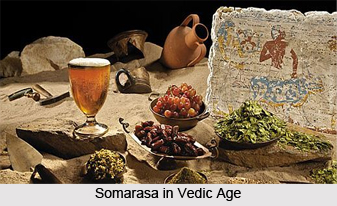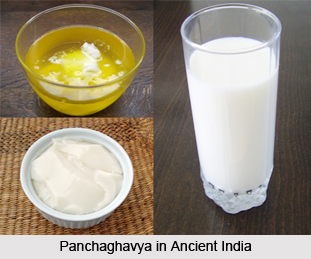 Food in Ancient India basically reflects the cultural evolution of Indian civilization from ancient past. Early Indians ate food that was easily available from nature. Fruits, wild berries, meat, fish, etc. were the main food items of the nomadic dwellers. With the advent of civilization, people settled and started to do farming. This led to the discovery of food crops, pulses, etc. Food in ancient India was cultivated in the fertile river valleys. Rice was their staple food that was eaten with cooked lentils, vegetables and meat.
Food in Ancient India basically reflects the cultural evolution of Indian civilization from ancient past. Early Indians ate food that was easily available from nature. Fruits, wild berries, meat, fish, etc. were the main food items of the nomadic dwellers. With the advent of civilization, people settled and started to do farming. This led to the discovery of food crops, pulses, etc. Food in ancient India was cultivated in the fertile river valleys. Rice was their staple food that was eaten with cooked lentils, vegetables and meat.
Wheat was used to make flat breads known as "Chapati". The food habits of nearby countries also affected the food in ancient India. Cooking of chicken came to India from Thailand and mutton came from West Asia. The food pattern did not change with the arrival of the Aryans. With complex religious rituals taking the center stage, animal sacrifices peaked and more and more people turned vegetarians.
Milk and milk products came much into use during ancient times. Rice was eaten with curd. Cows were respected and worshipped hence people stopped eating beef. Most people in India became vegetarians and meat was consumed very rarely. Many spices were cultivated in India and were used in cooking for aroma and flavour. India flourished in the cultivation of spices and many of them were later exported to foreign lands.
Food in Ancient India can be divided into various ages that include food in Indus Valley civilisation, food in Vedic period, Food in Maurya period, food in Gupta period, food in post Gupta period which marked some difference with the advent of the Gujjars and Hunas. With the migration of outsiders in India changes were found within the food habits of India.
Food in Evolution of Indian Civilisation
Food in Ancient India developed considerably within the Indus Valley Civilisation which brought the use of wheat, barley, sesamum and brassica. Along with this, man had learned to tame buffaloes, goats and sheep which became useful for cultivation. Slowly and gradually this period marked the progress of man more towards civilized world with more scientific lifestyle.
The earliest Indians, the Harappans, probably ate mainly wheat and rice and chickpeas and lentils, and occasionally cows, pigs, sheep, goats and chicken. Indian cooks used many Central Asian herbs and spices - cinnamon, cumin, coriander, anise and fennel. Some of the wheat was made into stews or soups, and some into flat breads called "chapatis" or yeast breads called "naan". Indian people also enjoyed chewing on sugar cane, which grew naturally in India.
Food in Vedic Period
Food in Ancient India faced remarkable changes during the Vedic Period which not only introduced new food items but also rules and etiquettes while taking the meal of the day. This also introduced division of meals during the day. The food in Vedic period is largely divided into the food of the Aryans and Dravidians which later on got divided into north and south India. Their food items as well as habits have been illustrated in the sutras and Vedas of the period which are the earliest literature of ancient India.
Food in Maurya Period
Food in Ancient India that was adopted during the Maurya period has been extensively discussed by Kautilya. He defines the specifications of an ideal kitchen and a proper diet of the Raja in Maurya Empire which was largely followed as a convention by almost all the people living in Maurya Empire. While this also sets a number of special food items and food etiquettes, this at the same time describes the culture of ancient India. By around 300 BC, under the Mauryans, a lot of Hindus felt that animal sacrifices are added to ones karma and kept one from getting free of the wheel of reincarnation. Animal sacrifices became less popular, and although people didn"t give up eating meat entirely, they ate much less of it. A lot of people became vegetarians. Mauryan food scientists expanded fruit choices for these new vegetarians by breeding two different kinds of citrus fruit together to get oranges.
Food in Gupta period
Food in Ancient India which was adopted by the Gupta Empire was mainly influenced by Buddhism and Jainism which made a lot of changes in the culture of ancient India. In the Gupta period, around 650 AD, Hindus began to worship a Mother Goddess. Cows were sacred to her, and so Hindus stopped eating beef pretty much completely. About the same time, Indian scientists invented a way to make sugar cane juice into sugar cubes, so more people began to eat more sugar and sugary desserts. By 900 AD, new Central Asian fruits and vegetables, lemons and purple carrots, reached India too.
And then around 1100 AD, with the Islamic conquests in northern India, most people in India stopped eating pork as well, because it is forbidden by the Quran. People could still eat sheep or goats or chicken, but most of the people in India became vegetarians, and only ate meat very rarely or not at all.
The vegetarian food that Indians ate was mainly wheat flatbreads or a kind of flatbread made out of chickpeas, with a spicy vegetarian sauce with lentils and yogurt or people ate rice, with yogurt and vegetables.
Thus the food of ancient India has been marked with lot of changes from time to time that reflect the culture of assimilation within Indian culture. This got boosted with the advent of foreigners from outside India. The advent of Gujjars and Hunas did introduce a number of food items which remained inherent in ancient Indian culture.
Related Articles
Ancient History of India
Ancient Indian Culture
Indian culture
Rice
Panchagavya
Vedic Period
Gupta Empire
Maurya Empire
Indus Valley civilisation
Gujjars
Hunas
Aryans
Chapati



